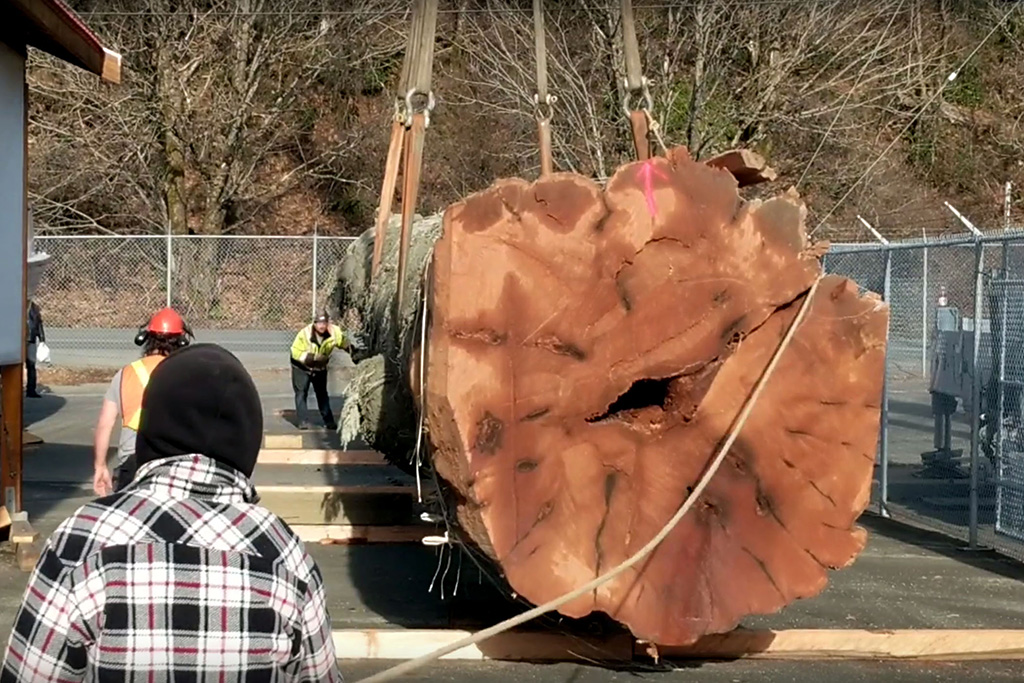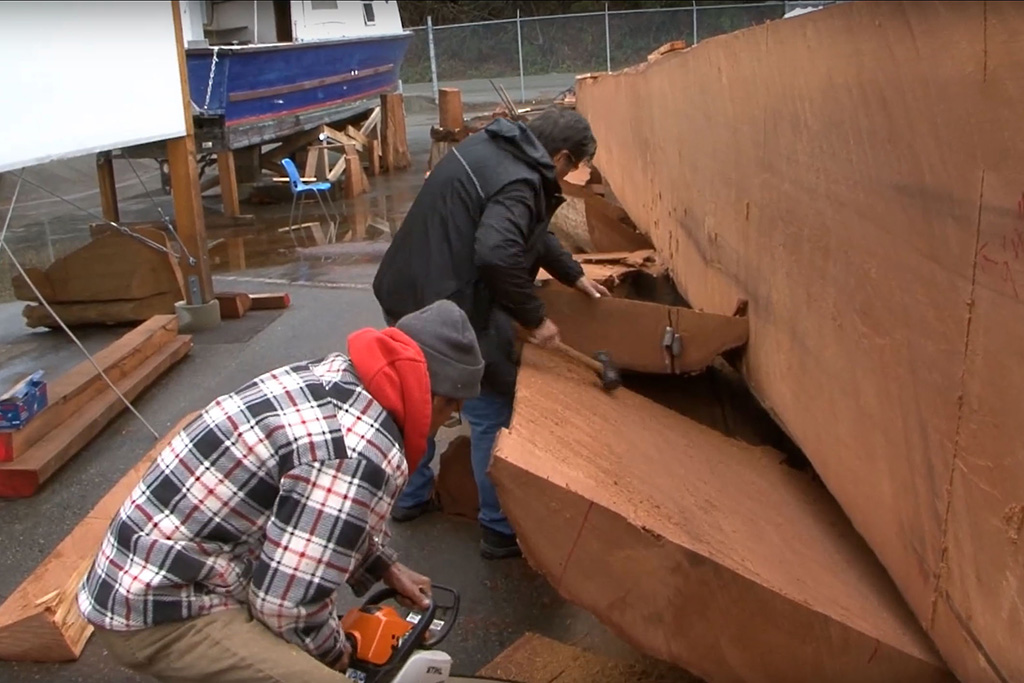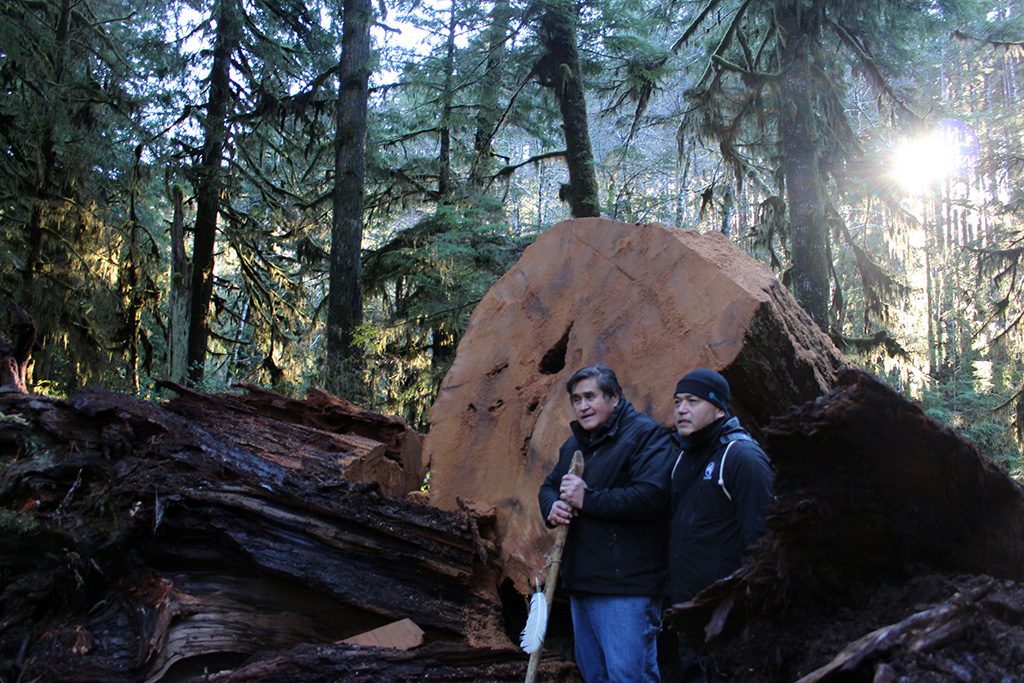A massive windthrown cedar tree has been resting on its side in the woods near Bamfield, B.C. for more than 50 years. In March, it was transported by truck and crane to the Port Alberni, where it will be transformed into the First Nations Education Foundation’s (FNEF) Language Revitalization Pole in recognition of the UN’s 2019 International Year of Indigenous Languages. For a wood carving of this size, it’s as much a construction project as a work of fine art.
The cedar log was chosen in December 2018 with the approval of Nuu-chah-nulth carver Tim Paul, who toured the Huu-ay-aht Treaty Settlement Lands and Western Forest Products TFL 44 areas to evaluate candidate logs for the project. Also on the expedition were FNEF executive director Scott Jeary and Port Alberni carver George Nookimus, who had already identified the location of the log used for the project.
More than 60 feet long and seven feet in diameter, the log weighs 73,000 lbs. and grew in the forest for roughly 800 years.
“I like to work in cedar and look for the grain when selecting a log,” Paul says. “We look for windthrows rather than cutting one down. A windfall is a real gift.”
Although he’s the project’s lead artist, Paul doesn’t like to be referred to as either an “expert” or a “master carver.” At 70 years of age, he says he’s still learning his craft. He comes from a family well-versed in arts such as basket making and canoe construction.
At age 11, he was sent to the former regional Nanaimo Indian Hospital with a possible diagnosis of tuberculosis.
“People from all over the area were doing handicraft work and leather work there,” he recalls. “There was one individual, Percy Jones from Nanaimo, who was a model pole carver. I always went to visit him at his bedside as he carved. He gave me two little pieces of cedar and a little knife to work on whatever I wanted. That’s where I carved my first two model poles.”
Sent to a residential school, Paul says he relied on his early childhood experiences of ceremony, celebration, masks and songs to inspire him. He continued to work in wood and was hired for a position at the Royal BC Museum where he was influenced by collections of First Nations cultural artifacts and world art. Today, his work is displayed in locations including the Museum of Civilization in Gatineau, the Museum of Art and Design in New York, Vancouver International Airport and countries as far away as England and New Zealand.
Jeary notes that the log was carefully hoisted by crane, lifted onto a truck and then transported along logging roads for four hours before arriving horizontally at the carving site at Port Alberni’s Maritime Heritage Society Discovery Centre.
Paul has been working with a crew of up to 12 in recent months to mill the log, remove bark and clean out extensive dry rot that ran halfway through its length. The log was rebuilt using replacement wood, bolts and glue to achieve the right dimensions.
“We work from the log’s centre line and then pencil in and block out the shapes, for example the head and the chest of the grizzly bear that traditionally forms the bottom of our poles,” says Paul.
The heavy work is being handled by his old reliable Husqvarna chainsaw. Finer detail work will be completed using a series of specialized carving knives and adzes.
“We use very specific tools for tasks such as carving out mouths and eye sockets,” says Paul. “When we need a specialized tool for a certain job, I’ve known associates to create that tool right then and there. You improvise and create what you need.”
The work is being completed in an open studio, inviting the public, including cruise ship passengers, to view the work in progress. Once carved and painted, the pole is scheduled to be delivered to its final destination at the University of Victoria in November.
The carving follows the detailed drawings of the many figures who will grace the pole when completed. At the top is the Sky Chief, who oversees all, and the sun and the stars. At the base is the Sea Chief and the land, represented by the grizzly bear.
Somewhere between is the thunderbird, who has the power to keep human arrogance in check with a flap of his wings. It’s a reminder that even the most carefully planned work of art may need to take a cue from the natural material from which it is created.
“The cedar is the boss,” Paul says. “Don’t ever think that you are.”

1/2
FIRST NATIONS EDUCATION FOUNDATION











Recent Comments